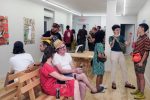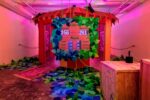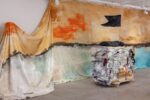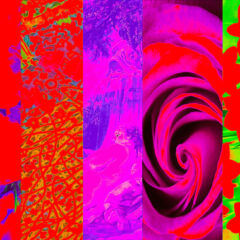Reclaiming American themes in art is a tall order, since Life, Liberty and the Pursuit of Happiness is locked in the popular imagination in a space both vast and nebulous. Nari Ward offers instead to reinvigorate the experience of that space.
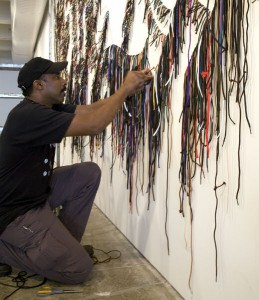
During his artist’s talk (video clip here) at The Fabric Workshop and Museum (FWM), we gathered around his pieces to hear about the materials and themes illuminated by his personal attitudes towards technology, immigration, and geopolitical signs and signifiers. We the People unites us all regardless of identity, and allows us to impose our own subjective experience on the work.
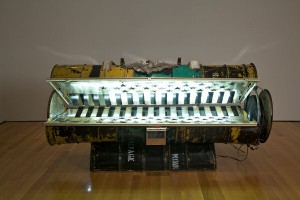
When introducing his 2006 Whitney Biennial piece, “Glory,” Ward traces back the origins of the American flag tanning pattern inside the bed of recycled oil barrels. Hailing from St Andrews, Jamaica, Ward moved to New York as a teenager. His work challenges beliefs about Jamaican culture as well as post 9/11 American culture.
We approach “Glory” from Ward’s transnational points of view as well as our individual perspectives. Faced with my own set of commercial appropriations and cultural misinterpretations as an immigrant, I ruminated on the UV rays behind stars and stripes encased in oil barrels, while fellow audience members further developed Ward’s ideas on national identity amidst the violence of American foreign policy.
Before moving on, we’re given insight into the video playing in the main room, where much of the reception is held. We walk by “Father and Sons” only to arrive at it after the talk with a richer sense of the themes this piece involves. Upon regrouping upstairs in front of “We the People” – the Constitution preamble script made of hundreds of used shoelaces – Ward reveals the topical fact that he recently passed his citizenship test.
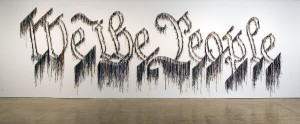
His own words and story underscore the “new presence” these oft-read words take on through use of the materials and the large span of the piece. Opposite this work, a wall of black TV backs named “Airplane Tears,” also on a similarly grand scale, re-examines the materiality of salvaged objects—in this case, “technology on its way out.” Elsewhere in the show, multiple meanings exist in the repurposed shoes, fences, and pews, as well as newly-created commercial logos. For viewers with media images from Seattle WTO and Iraq War protests seared into their memories, logos like “Third World Bank” perhaps appear dated. However, Ward’s prescient “Charging Bull” on Wall Street reminds us how often his ideas spanning the last couple decades hit the mark.
While artists talks can occasionally over explain works to their detriment, Ward’s words in regards to his recent citizenship helped me return to “Father and Sons” with a deeper resonance in regard to the recorded “incantation.” On screen, teenage sons of an African American police officer recite muffled Miranda rights while sharing a podium with their uniformed father.
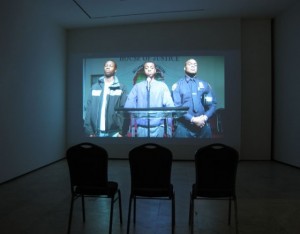
The camera focuses on the sons’ hands moving over the police badge and catches the father advising the sons. Ward intricately layers the anxiety, tension, and paradoxes these figures represent in American society. Along with these uncertain external expectations, the muffled voices express the uncertainty of Miranda rights post-Patriot Act in America. Not only did this piece blur authority of the state with familial dynamics, but for me it also blended with Ward’s personal citizenship experience. Though pre-dating his citizenship test which ends with the Pledge of Allegiance, the recitation of sacred rights invokes all concerns about eroding rights of American citizens. Lastly, the artist talk served to unify the multi-storied FWM space that, like Ward’s work, presents a shared but mutable experience.


